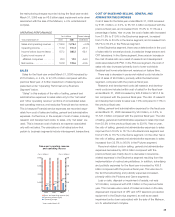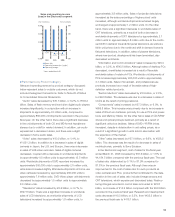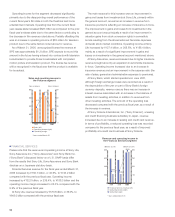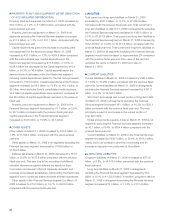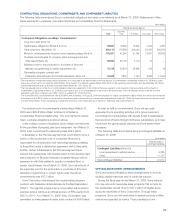Sony 2006 Annual Report Download - page 60
Download and view the complete annual report
Please find page 60 of the 2006 Sony annual report below. You can navigate through the pages in the report by either clicking on the pages listed below, or by using the keyword search tool below to find specific information within the annual report.
58
Excluding the operating income recorded in the music
business, a loss was recorded within All Other mainly as the
result of an asset impairment write-down associated with the
sale of the Metreon, a U.S. entertainment complex. This was
offset to some extent by cost reductions at network-related
businesses within Sony Corporation.
In June 2006, Sony Corporation transferred 51% stock of
StylingLife Holdings Inc., a holding company covering six retail
companies within Sony previously included within All Other, to a
wholly-owned subsidiary of Nikko Principal Investments Japan
Ltd. As a result of this transaction, Sony recognized a ¥18.0 billion
gain on change in interest in subsidiaries and equity investees
during the first quarter of the fiscal year ending March 31, 2007.
FOREIGN EXCHANGE FLUCTUATIONS AND RISK
HEDGING
During the fiscal year ended March 31, 2006, the average value
of the yen was ¥112.3 against the U.S. dollar, and ¥136.3
against the Euro, which was 5.1% lower against the U.S. dollar
and 2.0% lower against the Euro, respectively, compared with
the average of the previous fiscal year. Operating results on a
local currency basis described in “Overview” and “Operating
Performance” show results of sales and operating revenue and
operating income obtained by applying the yen’s monthly average
exchange rate in the previous fiscal year to monthly local
currency-denominated sales, cost of sales, and selling, general
and administrative expenses for the fiscal year ended March 31,
2006, as if the value of the yen had remained constant.
In the Pictures segment, Sony translates into yen the U.S.
dollar consolidated results of SPE (a U.S.-based operation that
has worldwide subsidiaries).
Therefore, analysis and discussion of certain portions of the
operating results of SPE are specified as being on “a U.S. dollar
basis.” Results on a local currency basis and results on a U.S.
dollar basis are not on the same basis as Sony’s consolidated
financial statements and do not conform with U.S. GAAP. In
addition, Sony does not believe that these measures are a
substitute for U.S. GAAP measures. However, Sony believes
that local currency basis results provide additional useful
information to investors regarding operating performance.
Sony’s consolidated results are subject to foreign currency
rate fluctuations mainly derived from the fact that the countries
where manufacturing takes place may be different from those
where such products are sold. In order to reduce the risk
caused by such fluctuations, Sony employs derivatives, including
foreign exchange forward contracts and foreign currency option
contracts, in accordance with a consistent risk management
strategy. Such derivatives are used primarily to mitigate the
effect of foreign currency exchange rate fluctuations on cash
flows generated by anticipated intercompany transactions and
intercompany accounts receivable and payable denominated in
foreign currencies.
Sony Global Treasury Services Plc (“SGTS”) in London
provides integrated treasury services for Sony Corporation and
its subsidiaries. Sony’s policy is that Sony Corporation and all
subsidiaries with foreign exchange exposures should enter into
commitments with SGTS for hedging their exposures. Sony
Corporation and most of its subsidiaries utilize SGTS for this
purpose. The concentration of foreign exchange exposures at
SGTS means that, in effect, SGTS hedges the net foreign
exchange exposure of Sony Corporation and its subsidiaries.
SGTS in turn enters into foreign exchange transactions with
creditworthy third-party financial institutions. Most of the trans-
actions are entered into against projected exposures before the
actual export and import transactions take place. In general,
SGTS hedges the projected exposures on average three months
before the actual transactions take place. However, in certain
cases SGTS partially hedges the projected exposures one
month before the actual transactions take place when business
requirements such as shorter production-sales cycle for certain
products arise. Sony enters into foreign exchange transactions
with financial institutions primarily for hedging purposes. Sony
does not use these derivative financial instruments for trading or
speculative purposes except for certain derivatives in the
Sales and operating income (loss)
in All Other
2004 2005 2006
–2.4%
0.9%
750
500
250
0
–250
60
40
20
0
–20
4.0%
(Yen in billions) (Yen in billions)
■ Sales (left)
■ Operating income (loss) (right)
● Operating margin
*Years ended March 31



